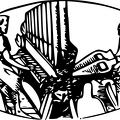The organ, already introduced into divine service, became, under the hands of St. Dunstan, a large and important instrument. William of Malmesbury says that Dunstan gave many to churches which had pipes of brass and were inflated with bellows. In a MS. psalter in Trinity College, Cambridge, is a picture of one of considerable size, which has no less than four bellows played by four men.
[Comment on the same picture in book Musical Instruments, by Carl Engel Published in 1875 and Available from gutenberg.org]
Some progress in the construction of the organ is exhibited in an illustration dating from the twelfth century, in a psalter of Eadwine, in the library of Trinity college, Cambridge. The instrument has ten pipes, or perhaps fourteen, as four of them appear to be double pipes. It required four men exerting all their power to produce the necessary wind, and two men to play the instrument. Moreover, both players seem also to be busily engaged in directing the blowers about the proper supply of wind. Six men and only fourteen pipes! It must be admitted that since the twelfth century some progress has been made, at all events, in the construction of the organ.
- Author
- The Project Gutenberg EBook of Manners, Custom and Dress During the Middle Ages and During the Renaissance Period, by Paul Lacroix
- Posted on
- Tuesday 3 March 2020
- Dimensions
- 593*340
- Albums
- Visits
- 977
- Downloads
- 20
 Download Photo
Download Photo




